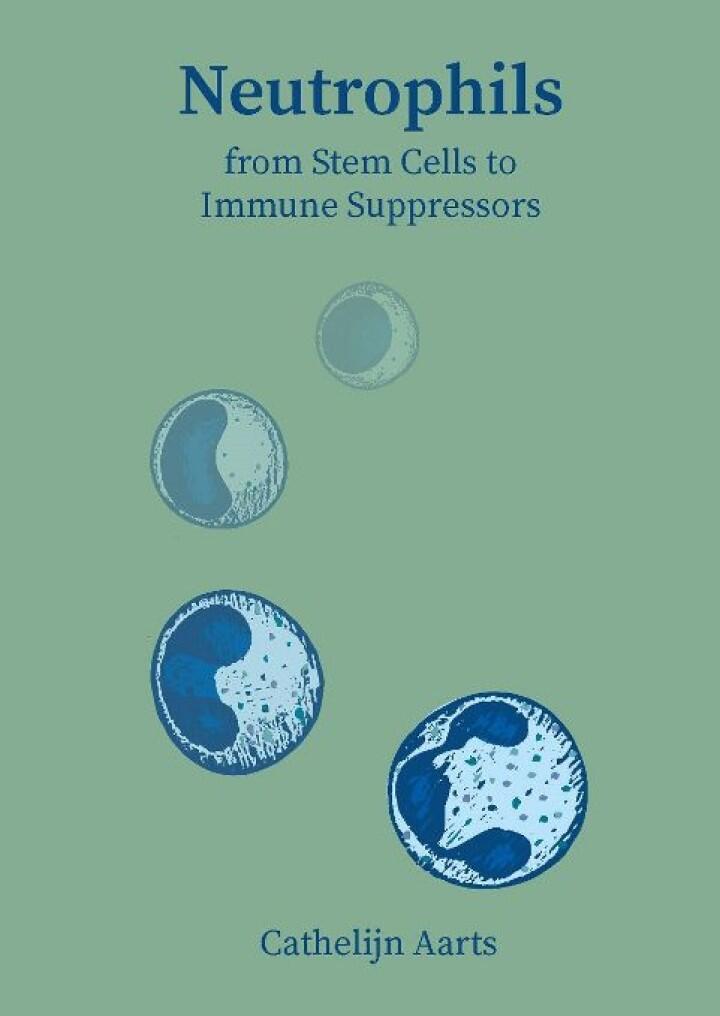Thesis Cathelijn Aarts
On 11 January 2022 (15:00) Sanquin researcher Cathelijn Aarts defended her thesis 'Neutrophils, from Stem Cells to Immune Suppressors' at the University of Amsterdam.
Promotor: Prof TW Kuijpers MD PhD
Copromotores: MM von Lindern PhD and E van den Akker PhD
Venue: Agnietenkapel, University of Amsterdam (invitation only) and online
Summary
In this thesis we established and applied different models to investigate neutrophil development in relation to effector functions in more depth. To unravel underlying mechanisms or phenotypes in neutrophil immune defects, we show in part I of this thesis the potential of iPSCs and CD34+ HSCs as a disease model for neutrophil development. In part II of the thesis we address the recently established – and more controversial – function of mature neutrophils as MDSCs. With our set-up to assess MDSC activity in vitro, we investigated in more depth the mechanism of the suppressive activity and whether this activity was restricted to some extent to certain developmental or (re)programmed neutrophil subsets in health or under certain disease conditions. With our set-up to assess MDSC activity in vitro, using an adapted culture system based on previous experience, it has been proven to be of immense help to identify which developmental programming or activities are key to obtain the various neutrophil-specific effector activities, including MDSC activity, as we will describe in the subsequent chapters of this thesis.
Chapters
Chapter 1
General introduction and outline of this thesis
PART I – STEM CELL-DERIVED NEUTROPHILS TO MODEL HUMAN DISEASE
Chapter 2
Generation and characterization of patient-derived iPSC lines
2.1 Generation and characterization of a human iPSC line SANi006-A from a Gray Platelet Syndrome patient Abstract
2.2 Generation and characterization of a human iPSC line SANi007-A from a patient with a heterozygous dominant mutation in ELANE Abstract
2.3 Generation and characterization of a human iPSC line SANi008-A from a Chédiak-Higashi Syndrome patient Abstract
2.4 Generation and characterization of a control and patient-derived human iPSC line containing the Hermansky Pudlak type 2 associated heterozygous compound mutation in AP3B1 Abstract
Chapter 3
Efficient production of erythroid, megakaryoid and myeloid cells, using single cell-derived iPSC colony differentiation Abstract
Chapter 4
Induced pluripotent stem cell-derived neutrophils to model Hermansky Pudlak syndrome type 2
Chapter 5
Neutrophil specific granule deficiency and impaired NETosis in Gray Platelet Syndrome caused by NBEAL2 deficiency Abstract
PART II – NEUTROPHILS AS MYELOID-DERIVED SUPPRESSOR CELLS
Chapter 6
Activated neutrophils exert myeloid-derived suppressor cell activity damaging T cells beyond repair Abstract
Chapter 7
Neutrophils as suppressors of T cell proliferation: Does age matter? Abstract
Chapter 8
Different MDSC activity of G-CSF/Dexamethasone mobilized neutrophils: benefits to the patient? Abstract
Chapter 9
General Discussion
Download
Download PhD thesis (university repository)
